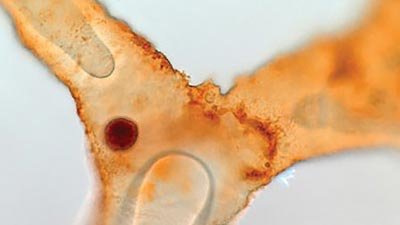Tyrannosaurus rex: a Big Chicken?
Perhaps one of the most exciting recent discoveries for creationists has been the report of soft tissue found in a dinosaur fossil.1 In 2005, a study in the prestigious journal Science documented the presence of unfossilized tissue from a T. rex.2 Since these dinosaurs are supposed to have been extinct for at least 65 million years, finding soft tissue was quite a surprise for evolutionists. The soft tissue was only partially mineralized; after the minerals were removed, the tissue was “stretchy” and had the appearance of blood vessels.
The finding of unfossilized dinosaur tissue is a serious blow to the idea of an earth millions of years old, but it is not the only example. Recently, scientists have also obtained bone marrow that could contain DNA from fossil frogs and salamanders that were supposed to be 10 million years old.3
One of the most exciting recent discoveries for creationists has been the report of soft tissue found in a dinosaur fossil.
Conventional wisdom held that proteins and DNA could not survive for millions of years. Indeed, an upper limit to the preservation of a stable protein such as collagen was presumed to be about 2.7 million years at 0°C, 180,000 years at 10°C, and only 15,000 years at 20°C.4 Thus, there was much skepticism that what Schweitzer found was really dinosaur soft tissue when it was initially reported. Secular scientists were hesitant to believe that such tissue and proteins could persist for more than 65 million years.
Now for What’s New
The newest development regarding this dinosaur concerns this week’s announcement that what was found in this T. rex fossil supposedly presents strong evidence that dinosaurs evolved into birds. Here is the background.
Dr. Schweitzer has reported that the protein collagen has been recovered from her T. rex soft tissue specimen.5 The pair of papers are very careful and cautious studies making use of some sophisticated experiments. These findings provide confirmation that the material is in fact dinosaur soft tissue.
Researchers used several different techniques to identify the presence of collagen. First, they found that antibodies to collagen would bind to the samples, and this binding did not occur after treatment with enzymes that specifically degrade collagen. Second, they used mass spectrometry to determine the amino acid sequence of the protein. They then mapped various protein fragments and compared them against a database of protein sequences from a variety of organisms.
Of all the organisms in the sequence database, the one that matched T. rex the closest was the chicken. Now, before assuming that this would be strong evidence that birds are related to dinosaurs, it must be put into perspective. The sequence similarity between the T. rex and the chicken was 58%, while it was only 51% similar to both frogs and newts. This compares with a reported 81% similarity between humans and frogs, and 97% between humans and cows.6 Moreover, while some of the peptide fragments showed sequence matches to chickens, others matched frog, or newt, or even fish and mice. The authors did point out that not all organisms are in the database. Although the chicken was the closest match from the database, it is possible that animals not included could be a closer match. Regardless, such similarity does not prove that the organisms shared an evolutionary ancestor.
Certainly the recovery of protein sequences from fossil dinosaurs should be applauded—and that work is solid. However, the use of such sequence data to support the idea that birds evolved from dinosaurs is a stretch.7
Interestingly, the amount of protein that they could recover decreased over time. In other words, the amount that they could recover in recent extractions was reduced compared to previous extractions. This suggested that there was degradation of the sample in its current “modern” environment. The fact that such degradation is occurring over very short time scales poses a potential difficulty for evolutionists in explaining how the material could have persisted for an alleged 68 million years.
These are very exciting papers and provide strong evidence that dinosaur soft tissue has been recovered, but they don’t reveal a dino-bird link. Unfortunately, these observations will unlikely dissuade those who are firmly convinced of molecules-to-man evolution and millions of years.
Editor’s note: See “T. rex Drumstick” about this recent dinosaur research, which also briefly looks at the biblical significance of this story.
<Footnotes
- See “The Scrambling Continues” and “‘Ostrich-Osaurus’ Discovery?”
- Mary H. Schweitzer, Jennifer L. Wittmeyer, John R. Horner, and Jan K. Toporski, “Soft-Tissue Vessels and Cellular Preservation in Tyrannosaurus rex,” Science 307, no. 5717 (March 25, 2005): 1952–1955, doi:10.1126/science.1108397.
- Maria E. McNamara, Patrick J. Orr, Stuart L. Kearns, Luis Alcalá, Pere Anadón, and Enrique Peñalver-Mollá, “High-Fidelity Organic Preservation of Bone Marrow in Ca.10 Ma Amphibians,” Geology 34, no. 8 (August 1, 2006): 641–644, doi:10.1130/G22526.1; and Helen Briggs, “Fossil Frogs Yield ‘Soft Tissues’,” BBC News, July 26, 2006, http://news.bbc.co.uk/2/hi/science/nature/5214798.stm.
- Christian Nielsen-Marsh, “Biomolecules in Fossil Remains: A Multidisciplinary Approach to Endurance,” The Biochemist (June 2002): 12–14, http://www.biochemist.org/bio/02403/0012/024030012.pdf.
- Mary H. Schweitzer et al., “Analyses of Soft Tissue from Tyrannosaurus rex Suggest the Presence of Protein,” Science 316, no. 5822 (April 13, 2007): 277–280, doi:10.1126/science.1138709; and John M. Asara, Mary H. Schweitzer, Lisa M. Freimark, Matthew Phillips, and Lewis C. Cantley, “Protein Sequences from Mastodon and Tyrannosaurus rex Revealed by Mass Spectrometry,” Science 316, no. 5822 (April 13, 2007): 280–285, doi:10.1126/science.1137614.
- Asara et al., “Protein Sequences from Mastodon and Tyrannosaurus rex Revealed by Mass Spectrometry.”
- Media have emphasized the dinosaur-bird link, e.g., Jeanna Bryner, “T. rex Related to Chickens,” LiveScience, April 12, 2007, https://www.livescience.com/1410-rex-related-chickens.html.
Recommended Resources

Answers in Genesis is an apologetics ministry, dedicated to helping Christians defend their faith and proclaim the good news of Jesus Christ.
- Customer Service 800.778.3390
- Available Monday–Friday | 9 AM–5 PM ET
- © 2026 Answers in Genesis





